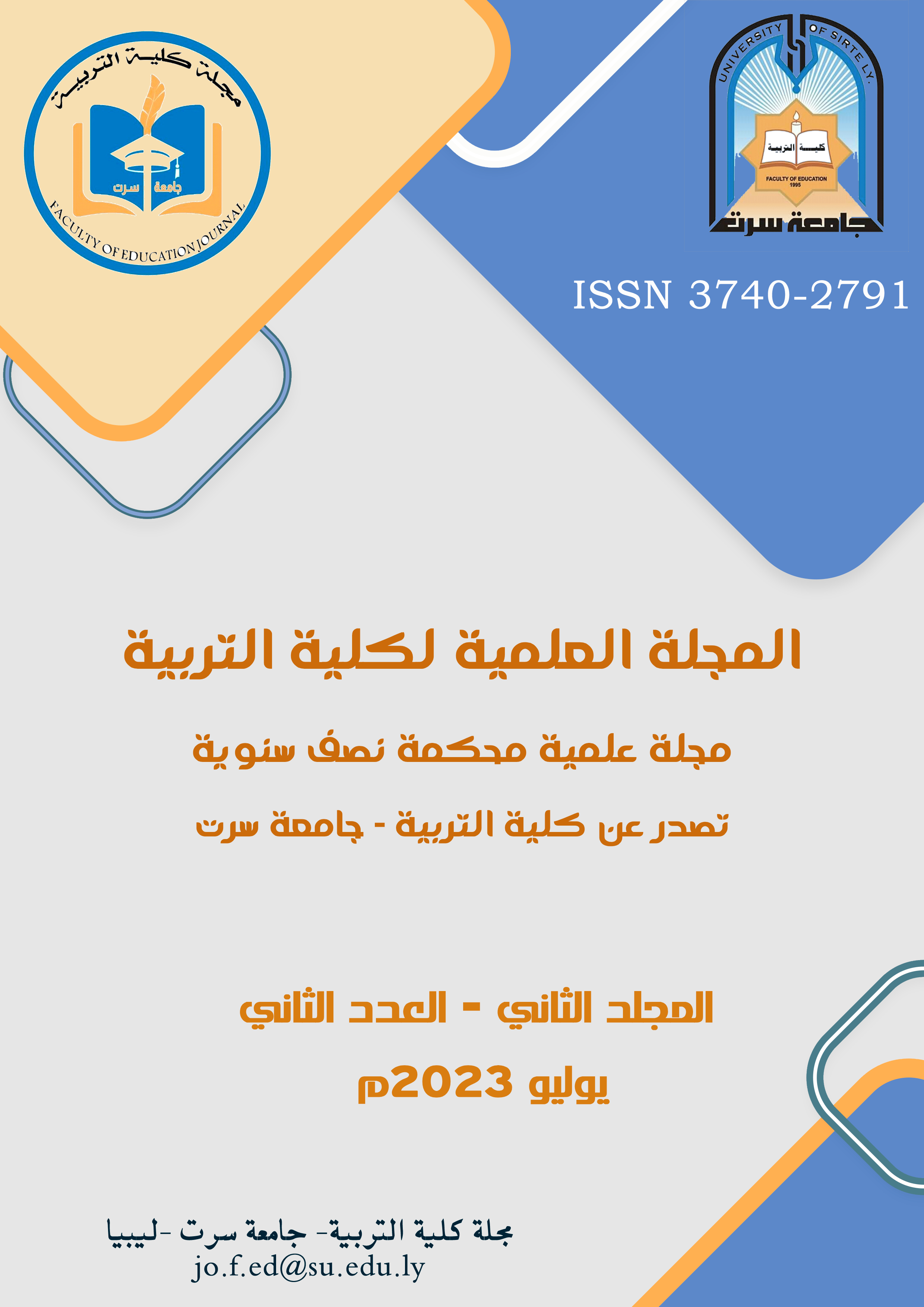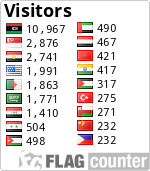Effective Ways to Teach English Language Skills at the Secondary School Level in Libya
DOI:
https://doi.org/10.37375/foej.v2i2.1562الكلمات المفتاحية:
Vocabulary, Grammar, Listening, Speaking, Reading and Writingالملخص
Teaching English language skills to the students since the time they are introduced to study English as a subject in their curriculum at schools is an important area of concern in Libya. The main objective of this paper is to suggest the effective ways to teach English language skills at the secondary school level in Libya. This study is conducted at the secondary school located in Brack town in Wadi Alshatti region in Libya. The students are given a questionnaire for their feedback regarding the way they are taught different areas of English language like vocabulary, grammar, listening, speaking by their teachers and a few oral questions are also asked to just guess the English language skills of the students. Finally, the paper presents the findings and recommendations. Lack of enough vocabulary and knowledge of grammar are seen as the main factors crippling the English language learning skills among the learners.
المراجع
References
Abdalhamid, F. (2012). Listening comprehension strategies of Arabic-speaking ESL learners (Unpublished Master’s dissertation). Department of English, Colorado State University, Fort Collins, Colorado.
Alber-Morgan, S. (2006). Ten ways to enhance the effectiveness of repeated readings. Journal of Early and Intensive Behaviour Intervention, 3(3), 273-279.
Al-Tamimi, N. O. M., & Attamimi, R. A. (2014). Effectiveness of cooperative learning in enhancing speaking skills and attitudes towards learning English. International Journal of Linguistics, 6(4), 27.
Biemiller A., Slonim N. (2001). Estimating root word vocabulary growth in normative and advantaged populations: Evidence for a common sequence of vocabulary acquisition. Journal of Educational Psychology, 93, 498-520
Brown, H. D. (2007). Teaching by Principles. (3rd ed.). London: Longman
Carl B, S. (2003). Vocabulary development: Elaboration for writing. ERIC Topical Bibliography and Commentary, (071), 3-6. Retrieved from the ERIC database
Carl B, S. (2003a). Vocabulary development: Elaboration for writing. ERIC Topical Bibliography and Commentary, (071), 3-6. Retrieved from theERIC database.
Carl B, S. (2003b). Vocabulary’s influence on successful writing. ERIC Publications,(071), 3-6. Retrieved from the ERIC database.
Croll, C. (1971). Teaching vocabulary. College Composition and Communication, 22(5), 378-380. Retrieved from the ERIC database.
Cutler L. and Graham S (2008) ‘Primary grade writing instruction: a national survey’, Journal of Educational Psychology, 100(4):907, doi:10.1037/a0012656.
Darti, D., &Asmawati, A. (2017). Analyzing students’ difficulties toward listening comprehension. English, Teaching, Learning and Research Journal, 3(2) 211-228, https://doi.org/10.24252/Eternal. V32.2017.A9
Derakhshan, A., Khalili, A., &Beheshti, F. (2016). Developing EFL learner’s speaking ability, Accuracy and Fluency. Canadian Centre of Science and Education, 6. Retrieved from www.ccsenet.org/journal/index.php/ells/artile/viewfile/60070/32159
Doughty, C. (2003). Instructed SLA: Constraints, compensation, and enhancement. In M. Long, & C. Doughty (Eds.). The handbook of second language acquisition (pp. 256-310). Malden, MA: Blackwell Publishing Ltd.
Ediger, M. (1999). Reading and vocabulary development. Journal of Instructional Psychology, 26(1), 7. Retrieved from the Academic SearchPremier database.
Ellis, R. (2006). Current Issues in the Teaching of Grammar: An SLA Perspectie.TESOLQaurterly, 40(1) 83-107. https://www.jstor.org/stable/40264512
Ellis, R. (1994). The Study of Second Language Acquisition Oxford: Oxford University Press: 630-642
Folse, K. S. (2004). Vocabulary myths: Applying second language research the classroom teaching. Ann Arbor: University of Michigan Press.
Gautam, P. (2019). Writing Skill: An instructional overview. Journal of NELTA Gandaki, 2, 74–90. https://doi.org/https://doi.org/10.3126/jong.v2i0.26605
Gilakjani, A.P., & Ahmadi, M.R. (2011). A study of factors affecting EFL learners’ English listening comprehension and the strategies for improvement. Journal of Language Teaching and Research. 2(5), 9-988. https://doi.org/10.4304/jltr.2.5.977-988
Goh, C. (2000). A Cognitive Perspective on Language Learners’ Listening Comprehension Problems. System, 28, 55-75. http://dx.doi.org/10.1016/S0346-251X(99)00060-3
Gough P.B., Tunmer W.E (1986).Decoding, reading and reading disability. Remedial and Special Education (1), 6-10
Graham S, Berninger VW, Abbott RD, Abbott SP and Whitaker D (1997) ‘Role of mechanics in composing of elementary school students: a new methodological approach’, Journal of Educational Psychology, 89(1):170, doi:10.1037/0022-0663.89.1.170.
Graham, S., &Perin, D. (2007). Writing next: Effective strategies to improve writing of adolescent in middle and high schools. NY: Alliance for excellent education.
Graham S and Perin D (2007a) ‘A meta-analysis of writing instruction for adolescent students’, Journal of Educational Psychology, 99(3):445, doi:10.1037/0022-0663.99.3.445.
Hadijah, S. (2014). Investigating the problems of English speaking of the students of Islamic boarding school program at Stain Samarinda. Dinamika Ilmu: Jurnal Pendidikan, 14(2), 240-247.
Hamouda, A. (2013). An Investigation of Listening Comprehension Problems Encountered by Saudi Students in the EL Listening Classroom. International Journal of Academic Research in Progressive Education and Development, 2(2), 113-15.
Harmer, G. (1998). How to teach English: An introduction to the practice of English language teaching. Essex: Longman
Jarvis, S, & Stephens, R. (1994). Going beyond Standard English: An Instructional Module for Improving International Business Communication. Paper presented at the Annual Conference on Languages and Commuication for World Business and the Professions (13th, Ypsilanti, MI, April 13-16, 1994). ERIC Document Reproduction Service No. ED. 377 738
Jozsef, H. (2001). Advanced writing in English as a foreign language: A corpus-based study of processes and products. France: The University of Precs.
Landauer T.K., Dumais S.T. (199). A solution to Plato’s problem: the latent semantic analysis theory of acquisition, induction, and representation of knowledge. Psychological ?Review, 104, 211-240
Orilina, N., &Suryani, L. (2017). Developing Listening for General Communication Course book for the First Semester Students of STKIP Siliwangi Bandung. Journal of Education and Learning, 5(1)
Martin, C. (2011, August). Providing support to families with specific regard to the removal of barriers that exist for families trying to provide academic support at home. Retrieved March 4, 2015, from http://files.eric.ed.gov/fulltext/ED526878.pdf
Park, Y., & Lombardino, L. (2013) Exploring the nature of effective word study instruction for struggling readers: Practical applications for broader perspective of the simple view of reading. International Journal of Special Education, 28(1), 81-90. Retrieved February 6, 2015, from http://files.eric.ed.gov/fulltext/EJ1023311.pdf
Roberts, J. T. (1998). Grammar teaching. In Johnson, K & H. Johnson (eds.), (1998). Encyclopedic Dictionary of Applied Linguistics Oxford; Blackwell: 146-153.
Sharifan, F (Ed). (2009). English as an International Language: Perspectives and Pedagogical Issues. Bristol: Multilingual Matters.
Truss, L. (2003). Eats, shoots and leaves: The zero tolerance approach to punctuation. London: Profile books.
Yunus, M. Salehi, H &Amini, M. (2016). EFL teachers’ cognition of teaching English pronunciation techniques: A Mised-Method Approach. Canadian Center of Science and Education, 9. Retrieved from http://dex.doi.org/10.5539/elt.v9n2p20











